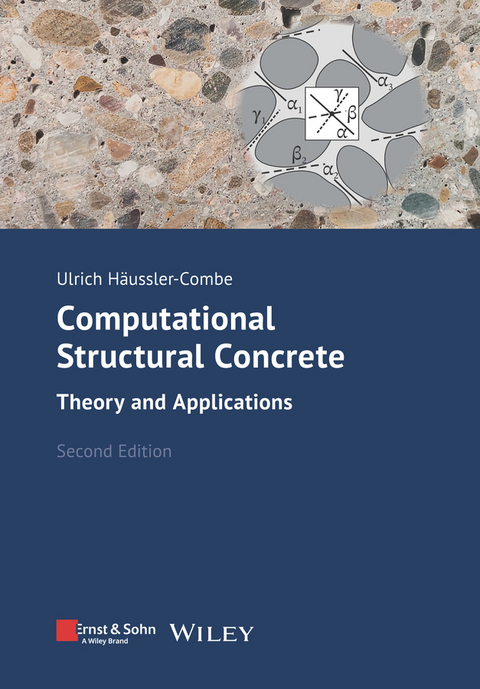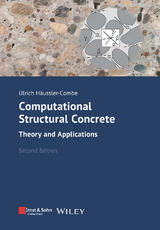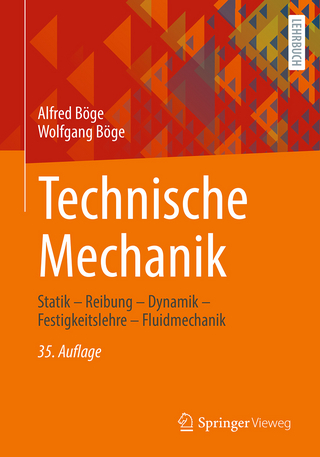Computational Structural Concrete
Ernst & Sohn (Verlag)
978-3-433-03310-4 (ISBN)
Ulrich Häussler-Combe studied structural engineering at the Technical University Dortmund and gained his doctorate from the University Karlsruhe. Following ten years of construction engineering and development in computational engineering, he came back to the University Karlsruhe as a lecturer for computer aided design and structural dynamics. In 2003 he was appointed as professor for special concrete structures at the Technical University Dresden. He retired in 2021 and currently is still active as guest professor at the Technical University Munich.
Preface
List of Examples*
Notation
1 INTRODUCTION
2 FINITE ELEMENTS OVERVIEW
2.1 Modelling Basics
2.2 Discretisation Outline
2.3 Elements
2.4 Material Behavior
2.5 Weak Equilibrium
2.6 Spatial Discretisation
2.7 Numerical Integration
2.8 Equation Solution Methods
2.9 Discretisation Errors
3 UNIAXIAL REINFORCED CONCRETE BEHAVIOUR
3.1 Uniaxial Stress-Strain Behaviour of Concrete
3.2 Long-Term Behaviour - Creep and Imposed Strains
3.3 Reinforcing Steel Stress-Strain Behaviour
3.4 Bond between Concrete and Reinforcement
3.5 Smeared Crack Model
3.6 Reinforced Tension Bar
3.7 Tension Stiffening of Reinforced Bars
4 STRUCTURAL BEAMS AND FRAMES
4.1 Cross-Sectional Behaviour
4.2 Equilibrium of Beams
4.3 Finite Elements for Plane Beams
4.4 System Building and Solution
4.5 Creep of Concrete
4.6 Temperature and Shrinkage
4.7 Tension Stiffening
4.8 Prestressing
4.9 Large Displacements - Second-Order Analysis
4.10 Dynamics
5 STRUT-AND-TIE MODELS
5.1 Elastic Plate Solutions
5.2 Strut-and-Tie Modelling
5.3 Solution Methods for Trusses
5.4 Rigid Plastic Truss Models
5.5 Application Aspects
6 MULTI-AXIAL CONCRETE BEHAVIOUR
6.1 Basics
6.2 Continuum Mechanics
6.3 Isotropy, Linearity, and Orthotropy
6.4 Nonlinear Material Behaviour
6.5 Elasto-Plasticity
6.6 Damage
6.7 Damaged Elasto-Plasticity
6.8 The Microplane Model
6.9 General Requirements for Material Laws
7 CRACK MODELLING AND REGULARISATION
7.1 Basic Concepts of Crack Modelling
7.2 Mesh Dependency
7.3 Regularisation
7.4 Multi-Axial Smeared Crack Model
7.5 Gradient Methods
7.6 Overview of Discrete Crack Modelling
7.7 The Strong Discontinuity Approach
8 PLATES
8.1 Lower Bound Limit State Analysis
8.2 Cracked Concrete Modelling
8.3 Reinforcement and Bond
8.4 Integrated Reinforcement
8.5 Embedded Reinforcement with a Flexible Bond
9 SLABS
9.1 Classification
9.2 Cross-Sectional Behaviour
9.3 Equilibrium of Slabs
9.4 Reinforced Concrete Cross-Sections
9.5 Slab Elements
9.6 System Building and Solution Methods
9.7 Lower Bound Limit State Analysis
9.8 Nonlinear Kirchhoff Slabs
9.9 Upper Bound Limit State Analysis
10 SHELLS
10.1 Geometry and Displacements
10.2 Deformations
10.3 Shell Stresses and Material Laws
10.4 System Building
10.5 Slabs and Beams as a Special Case
10.6 Locking
10.7 Reinforced Concrete Shells
11 RANDOMNESS AND RELIABILITY
11.1 Uncertainty and Randomness
11.2 Failure Probability
11.3 Design and Safety Factors
12 CONCLUDING REMARKS
APPENDIX A SOLUTION METHODS
A.1 Nonlinear Algebraic Equations
A.2 Transient Analysis
A.3 Stiffness for Linear Concrete Compression
A.4 The Arc Length Method
APPENDIX B MATERIAL STABILITY
APPENDIX C CRACK WIDTH ESTIMATION
APPENDIX D TRANSFORMATIONS OF COORDINATE SYSTEMS
APPENDIX E REGRESSION ANALYSIS
References
Index
*LIST OF EXAMPLES
3.1 Tension bar with localisation
3.2 Tension bar with creep and imposed strains
3.3 Simple uniaxial smeared crack model
3.4 Reinforced concrete tension bar
4.1 Moment-curvature relations for given normal forces
4.2 Simple reinforced concrete (RC) beam
4.3 Creep deformations of RC beam
4.4 Effect of temperature actions on an RC beam
4.5 Effect of tension stiffening on an RC beam with external and temperature loading
4.6 Prestressed RC beam
4.7 Stability limit of cantilever column
4.8 Ultimate limit for RC cantilever column
4.9 Beam under impact load
5.1 Continuous interpolation of stress fields with the quad element
5.2 Deep beam with strut-and-tie model
5.3 Corbel with an elasto-plastic strut-and-tie model
6.1 Mises elasto-plasticity for uniaxial behavior
6.2 Uniaxial stress-strain relations with Hsieh-Ting-Chen damage
6.3 Stability of Hsieh-Ting-Chen uniaxial damage
6.4 Microplane uniaxial stress-strain relations with de Vree damage
7.1 Plain concrete plate with notch
7.2 Plain concrete plate with notch and crack band regularisation
7.3 2D smeared crack model with elasticity
7.4 Gradient damage formulation for the uniaxial tension bar
7.5 Phase field formulation for the uniaxial tension bar
7.6 Plain concrete plate with notch and SDA crack modeling
8.1 Reinforcement design for a deep beam with a limit state analysis
8.2 Simulation of cracked reinforced deep beam
8.3 Simulation of a single fibre connecting a dissected continuum
8.4 Reinforced concrete plate with flexible bond
9.1 Linear elastic slab with opening and free edges
9.2 Reinforcement design for a slab with opening and free edges with a limit state analysis
9.3 Computation of shear forces and shear design
9.4 Elasto-plastic slab with opening and free edges
9.5 Simple RC slab under concentrated loading
9.6 Simple RC slab with yield line method and distributed loading
9.7 Simple RC slab with yield line method and concentrated loading
10.1 Convergence study for linear simple slab
10.2 Simple RC slab with interaction of normal forces and bending
11.1 Analytical failure probability of cantilever column
11.2 Approximate failure probability of cantilever column with Monte Carlo integration
11.3 Simple partial safety factor derivation
| Erscheinungsdatum | 23.09.2021 |
|---|---|
| Verlagsort | Berlin |
| Sprache | englisch |
| Maße | 170 x 244 mm |
| Gewicht | 842 g |
| Themenwelt | Technik ► Bauwesen |
| Schlagworte | Bauingenieur- u. Bauwesen • Baustatik • Baustatik u. Baumechanik • Civil Engineering & Construction • Spannbeton • Spannbetontragwerk • Stahlbeton • Structural & Building Engineering • Structural Theory & Structural Mechanics • Structures • Tief- u. Hochbau / Massivbau • Tragwerk • Tragwerke |
| ISBN-10 | 3-433-03310-2 / 3433033102 |
| ISBN-13 | 978-3-433-03310-4 / 9783433033104 |
| Zustand | Neuware |
| Informationen gemäß Produktsicherheitsverordnung (GPSR) | |
| Haben Sie eine Frage zum Produkt? |
aus dem Bereich




